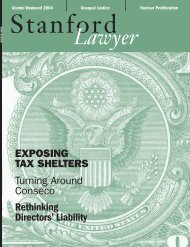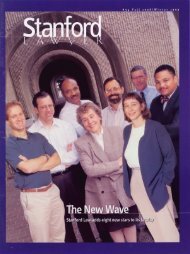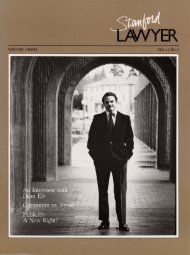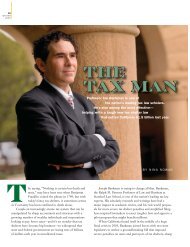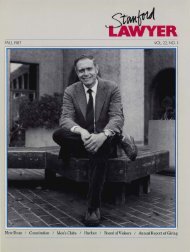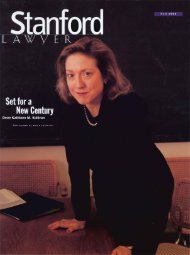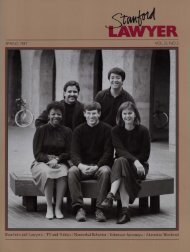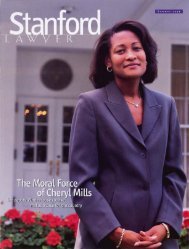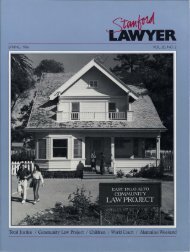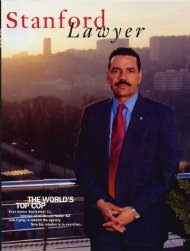26 t\ TORT STORYSUMMER<strong>2003</strong>according to news accOlUlts and the reminiscences of survivingfi-iends. But he was not primarily a plaintiffs' lawyer andby all accounts he was not an appellate lawyer who took casesto the state Supreme Court. Healy seems to have been morein his element, at least before the trial court, in defendingwhat appeared to be a routine premises liability case. But he,too, was not an appellate practitioner. In short, these werenot test case lawyers-~lIld this is transparent in the writtenrecord, which Justice Peters and his colleagues had beforethem when they decided to hear an appeal in the case.But that written record can only be understood in thecontext of a closer look at the obligations owing to a socialg1Jest when James Rowland had his fateful encounter withthe cracked faucet. Like every other state, California at thetime subscribed to the tripartite invitee-licensee-trespasserframework_ Significantly, however, Cali fornia appeared to doso in the most begrudging fashion. To be sure, as far asentrants on business premjses were concerned, tile CaliforniaSupreme Court, in Oettinge7' v. Stewrn1, had followed thestep taken by most states in broadly recognizing an obligationof due care, without reference to tile particularities ofwhether the proprietor stood to recognize an economic benefitfrom the entrant's presence. If Rowland's injury hadoccurred in the bathroom at his neighborhood cafe, hewould have been owed a full obligation of due care, evenif he stopped in solely to use the facilities.Social guests in a private residential setting, however,were anotller matter. Here, confusion reigned among thelower appellate courts and the California Supreme Courthad done virtually nothing to clarify matters. A number ofappellate court cases suggested that tile social guest took thepreneises as he or she found tleem; in other words, that theland occupier had no obligation to take safety precautionsbeyond whatever seemed personally adequate for the immediatefamily. Translated into a rule of conduct applicable tolicensees, this was frequently taken to mean that the landoccupier in California owed no duty beyond avoiding willfuland wanton injury to a visitor.By contrast, the vast majority of states required a warningto a social guest whenever the host had knowledge of adanger tllat he had reason to expect would not be discovered,a rule enunciated in the Restatement Second of Torts,§342. In short, the Restatement required warning of knownconcealed dangers, without reference to a standard of concealedrisk created by the land occupier's conduct that borderedon reckless misconduct.The confused state of the law in California, and indeedthe uneven doctrinal developments in other states as well,frequently boiled down to definitional haggling over whatconstituted a "trap." In earlier times, and in contemporaneousCalifornia decisions, the illustration often relied on wasa spring gun-surely suggesting a far more limited obligationfrom premises occupiers than if they had to concernthemselves about a range of "traps" including obscuredbanana peels in the front yard and slippery spots on the diningroom floor. But for William Prosser in the edition of hisauthoritative u-eatise on torts contemporaneous withRowland, "trap" had taken on a new, and more expansive,meaning:[Trap] originally was used in the sense of presenting anappearance of safety where it did not exist; but the significancewhich gradually became attached to it was not oneof intent to injure, or even of any active misconduct, butwas merely that the possessor of the land was under anobligation to disclose to the licensee any concealed dangerousconditions of the premises of which he had knowledge.Robert L. Rabin, A. Calder Mackay Professor of LawProsser's reference at this point is to the above-mentionedRestatement Second of Torts, §342-Prosser, itmight be noted, was the Reporter on the RestatementSecond-for what he characterizes as "the overwhelmingweight of authority."This, tllen, was the battletleld on which Berman andHealy clashed. Berman, unsurprisingly, was disabled immediately-theu'ial court granted summary judgment to defen-
1\ TORT STORY 27STANFORDLAWY ERdant on the pleadings-through his failure to allege whatwould have been the baseline requirement even in a majorityrule jurisdiction: a concealed defect. Undaunted, heappealed on behalf of Rowland, steadfastly sticking to hisguns in his statement of the case in the California court ofappeals: "Defendant knew that the handle was cracked andrealized that this constituted a dangerous condition." Onceagain, there is no averment on Rowland's behalf that thecrack was concealed. But then, almost as an afterthought, inthe argument section of the brief, which runs less than twopages in its entirety, Berman for the first time suggests that"the only question with which this court is faced is whetherthe crack qualified as a concealed danger or deceptive condition."Ifso, Berman continues, there is nothjng to stop thecourt from adopting "the trap exception to the rule of nonliability"-anexception that he inexplicably fails to define inthe handful of succeeding paragraphs in the argument.And so, the terms of engagement were set: Healy, inhis reply brief, argued that California had never adoptedRestatement Second, §342, and that the "so-called" trapexception, "[o]utside of deliberate, willful 'entrapment,'such as the maintenance of spring guns and other hideousdevices ... is largely a myth." Berman, in turn, in a replybrief hardly over a page in length, rejoins that there is nothingto stop the court from adopting §342 in the case athand. And there the matter ends-not a word urging thecourt to venture beyond clarification of the meaning of hiddendefect to reconsider the legitimacy of the categories.The court of appeals set its sights on the argumentsin the briefs, and quickly rehearsed three possibilities foraddressing the trap exception: that it was no part ofCalifornia law at all; that it had the narrow meaning suggestedby defendant's counsel; or, that it had the broad meaningsuggested by plaintiff. And then, not surprisingly, the courtheld that it need not decide the question at all- althoughits sentiments quite clearly ran to a narrow obligation, if any,on the part of social hosts-since "[no] source in the recordcontains any allegation, factual or conclusory, whichdescribes the faucet, its appearance, its location, the lighting,the bathroom, or ... any other fact which would support theconclusion that plaintiff was injured by a concealed danger."If, in hindsight, the dominant theme, as the case woundits way to the Supreme Court, was tunnel vision, the petitionfor a hearing before the high court served as the capstone.A word of context is necessary. At the time Rowlandwas decided there was no independent briefing before theSupreme Court; the Court reviewed cases de novo on thebasis of briefs filed in the court of appeals-and the petitionfor a hearing (which could run thirty pages or more). Shouldthe request for a hearing be granted, then, it is critical tonote that the petition and reply constituted the fmalmoment for the contesting parties to frame the issue, as theyconceived it. True to form, Berman argued exclusively foradoption of §342, and Healy, taking his cue from the courtof appeals decision, replied narrowly that there was no baselineaverment of a concealed defect that would warrantreconsideration of the summary judgment in defendant'sfavor. Neither submission reaches four pages in length, andnot a word is devoted to the possibility that the categoriesmight be abandoned.Might the possibility of abandoning the categories havebeen introduced at oral argument? Perhaps, but I can onlyoffer speculation, since oral arguments before the Courtwere neither transcribed nor recorded at the time. My interviewswith court clerks from the Rowland era suggest that,in most cases, when oral arguments were heard a draft of thefi~al opinion had already been prepared and circulated bythe Justice to whom opinion-writing had been assigned; inshort, that oral arguments were viewed as a formality for themost part. Very likely then, if the prospect of abandoningthe categories arose at all during oral arguments, it wason the initiative of the Justices rather than the parties.Whatever the case, the battle in the trenches in Rowland v.Chl'istian confirms in singular fashion that this was a courtprepared to refine and reformulate tort law according toits own lights, a proactive court extraordinaire.The AftermathAfter the Supreme Court remanded the case for trial underthe newly-enunciated standard of ordinary care owed to allland entrants, Berman referred the case to a San Franciscofirm of plaintiffs' litigation specialists, Walkup, Downing,Wallach & Stearns, who quickly settled the matter. In keepingwith the modest particulars of the case, surviving attorneysin that firm recall a settlement figure of under $10,000.Apparently, Rowland's injuries had healed without any lastingdifficulties. In fact, the major problem in getting thecase settled, as one former Walkup attorney recalls, is thatRowland had moved out of the state, and once located, wasannoyed about having to make a brief return appearance ina matter that was now far behind him. Nancy Christian herselfentirely lost interest in the case once her insurance carrier'slawyer, Healy, had finished deposing her, and nevereven bothered to inquire as to its outcome. Nor did she eversee Rowland again. None of this diminishes the significanceof the case, of course. Some landmarks of the law have lastingimpact on the lives of the immediate parties; others, likeRowland v. Christian, take on a life of their own, and the partiesget on with their personal affairs with hardly a glancebackwards.





